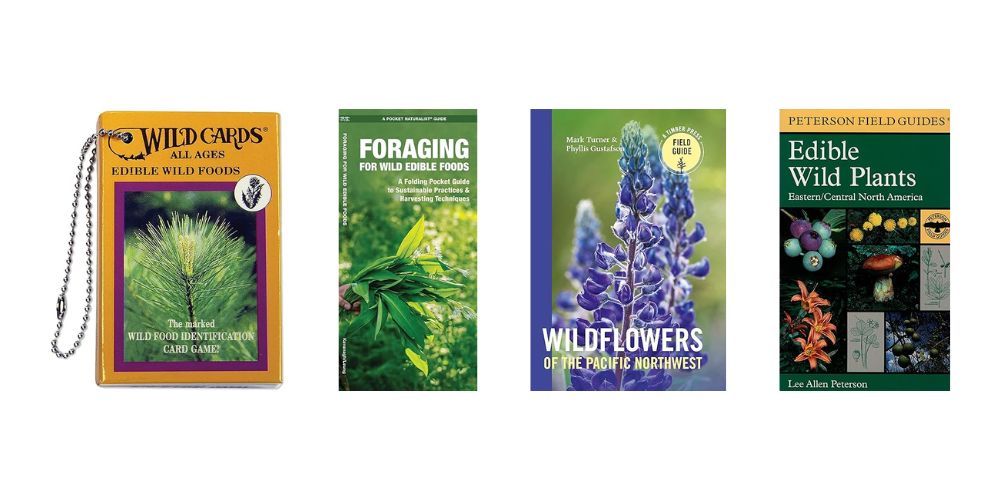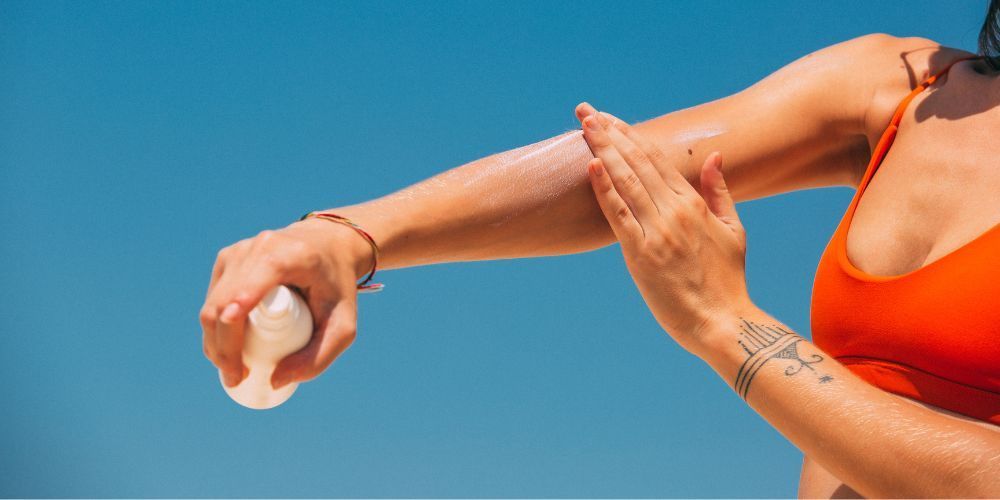Weekend Kayaking Trip Packing Guide: Expert Tips, Gear Checklist, and Essentials
August 30, 2024
Imagine gliding across calm waters at sunrise, every stroke of your paddle effortless thanks to its lightweight carbon fiber design. For many outdoor enthusiasts, just like you, embarking on a weekend kayaking trip means reconnecting with nature while ensuring every piece of gear meets both comfort and safety needs.
From securing a well-fitted life jacket perfect for storing small essentials to choosing dry bags that keep all your equipment safe even in unexpected rain, packing right can transform your journey. Whether you're navigating waves with a spray skirt or staying prepared with an essential first aid kit and communication devices, each item plays a crucial role. This guide distills expert advice and practical tips into a comprehensive checklist that promises not just survival but an enjoyable adventure out on the water.
When preparing for a weekend kayaking trip, it's crucial to pack the essentials such as a kayak, PFD (lifejacket), paddle, quick-dry clothing, map and compass, emergency signaling devices, safety kit, wetsuit, first aid kit, camping gear, and sleep systems. Additionally, consider bringing kitchen gear like a camp stove, collapsible dishware, water bottles or dromedary bag, water filter or iodine tablets, spork, tin mug, and larger pot/pots for group cooking. These items will help ensure a safe and enjoyable kayaking adventure.
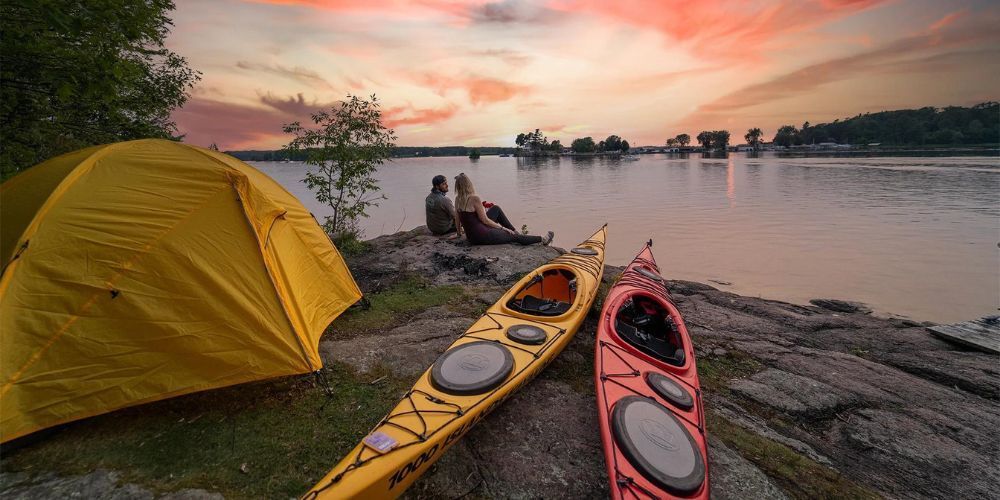
Essential Paddling Gear
The heart of your kayaking experience is, naturally, the kayak and paddle. When selecting a kayak, it's crucial to consider your skill level and the type of water you'll be navigating. For beginners, stable, wider kayaks are ideal, while experienced paddlers may prefer sleeker designs for better maneuverability. Similarly, paddles made from lightweight and durable materials such as carbon fiber are preferred for longer trips as they reduce fatigue and strain on your arms.
Furthermore, a personal flotation device (PFD) should be at the top of your gear list. Opt for a well-fitted PFD that is US Coast Guard-approved, ensuring that it provides maximum safety and protection on the water. Look for models with multiple pockets to conveniently store small essentials like a whistle, sunscreen, or snacks, keeping them within easy reach during your adventure.
To keep your gear dry and protected from water exposure, investing in high-quality dry bags is essential. These waterproof storage solutions come in various sizes to accommodate different items and can be easily stored in the compartments of your kayak. Brightly colored dry bags are not only practical for visibility but can also add a vibrant pop of color to your kayak ensemble.
Moreover, for kayaking in wavier or rougher waters, a spray skirt becomes indispensable. This essential piece of equipment acts as a protective barrier by sealing off the cockpit from water intrusion. It keeps you dry and comfortable even in challenging conditions, enhancing your overall kayaking experience.
By ensuring you have these fundamental paddling gear items packed and ready to go, you'll be equipped with everything you need to navigate the waters safely while enjoying a great kayaking adventure.
As we dive deeper into preparing for your kayaking expedition, let's now explore the crucial safety and emergency items you should have on hand to ensure a secure journey on the water.
Safety and Emergency Items
Before embarking on a weekend kayaking trip, whether it's on a serene lake or a rushing river, safety should always be the top priority. Having the right emergency items can be a lifesaver in critical situations. Here are some essential items to consider bringing along for your adventure.
First Aid Kit
An essential item for any outdoor excursion, a compact, waterproof first aid kit should contain supplies like bandages, antiseptic wipes, adhesive tape, and pain relievers. It should also include any personal medications that you or your group may require.
Imagine it's a sunny day, and you're leisurely kayaking down the river with friends enjoying the sights and sounds of nature. Suddenly, someone slips while getting out of their kayak. They cut their hand on an unseen rock just below the surface of the water. This is where a first aid kit becomes invaluable. With some antiseptic wipes and bandages from your well-prepared kit, you can swiftly clean and dress the wound, ensuring that an unfortunate accident doesn't turn into a potential emergency.
Whistle
A simple yet crucial tool, a whistle attached to your Personal Flotation Device (PFD) can serve as an effective signaling device in case of emergencies. Look for models that meet safety standards to ensure loudness and durability.
In an unexpected situation where visibility is low or you need to attract attention from a distance, a whistle can be a beacon of hope. If someone in your group becomes separated from the rest or if there's an urgent need for assistance, the high-pitched sound of a whistle carries further than a yell and can easily alert others to come to your aid.
VHF Radio or Satellite Phone
For more remote kayaking destinations, such as expansive lakes or open sea routes, ensuring you have reliable communication devices becomes all the more critical. A VHF marine radio or a satellite phone provides a direct line to emergency services should you need assistance while out on the water.
Imagine you're exploring a placid lake tucked away deep within a forested valley. Suddenly, you encounter unforeseen difficulties—perhaps due to changing weather conditions or equipment malfunctions. In such an isolated setting, having access to a VHF radio or satellite phone gives you peace of mind that help is just a call away. These devices become indispensable tools for ensuring not only your safety but also providing reassurance to loved ones waiting back on shore.
Emergency Signaling Devices
In case of an emergency situation where visibility is limited or communication becomes impossible, emergency signaling devices such as signal mirrors and flares can play a crucial role in attracting attention and swiftly summoning aid.
Consider navigating through an unfamiliar river with densely wooded banks when suddenly weather conditions take an unexpected turn. Thick fog envelops your surroundings and renders verbal communication impractical. In such instances of reduced visibility, being able to employ signal mirrors or flares could be fundamental in drawing attention from nearby rescuers.
Having these safety and emergency items readily available not only ensures your well-being during your kayaking expedition but also imparts peace of mind, allowing you to fully embrace and enjoy every moment of your adventure on the water.
Now that we've covered essentials for safety on your kayaking trip, let's move on to exploring the appropriate clothing needed for this aquatic adventure.
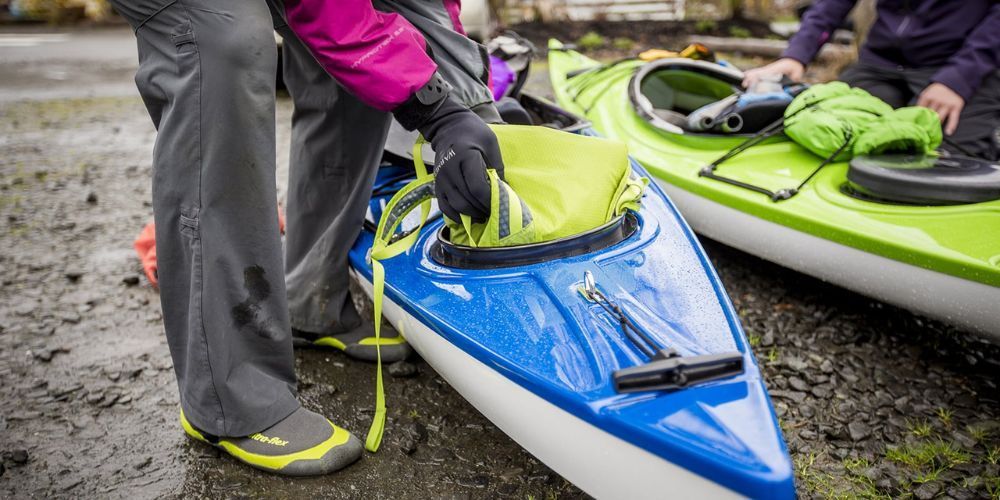
Appropriate Clothing for Kayaking
When preparing for a kayaking trip, selecting the right clothing isn't just about looking the part—it's about ensuring your comfort and safety while on the water. Key pieces of clothing can significantly enhance your experience.
First things first, quick-dry clothing is essential. These materials are designed to wick moisture away from your skin and dry quickly, keeping you comfortable even when you get wet. It's important to avoid wearing cotton as it retains moisture, leaving you feeling damp and uncomfortable.
Wetsuit or Dry Suit
For paddling in colder water temperatures, investing in a wetsuit or dry suit is crucial. A wetsuit offers thermal protection by trapping a thin layer of water between your body and the suit, which your body then heats up. On the other hand, a dry suit is perfect for kayaking in colder environments as it keeps you completely dry and provides excellent thermal insulation.
Both wetsuits and dry suits ensure warmth and protection in cold water conditions, enabling you to enjoy your kayak trip without worrying about getting too cold.
In terms of footwear, water shoes or neoprene boots are essential for protecting your feet from sharp rocks, shells, or any other debris that might be on the riverbed. They also offer better traction on slippery surfaces and provide comfort throughout your kayaking adventure.
Sun Protection Clothing
Long hours spent on the water require adequate sun protection. Investing in long-sleeved UV-protective shirts and wide-brim hats is important to guard against sun exposure. These not only shield your skin from harmful UV rays but also provide an added layer of protection against wind and surface water.
Some might see packing all this gear as a hassle. Still, these pieces of clothing are specifically designed to ensure your comfort and safety while kayaking.
As you can see, choosing appropriate clothing for kayaking is crucial for maintaining comfort and staying safe during your weekend escapade. The right attire not only protects you from the elements but also ensures that you can fully enjoy your time on the water without any discomfort or worries about exposure to the sun or cold water temperatures.
With the right clothing sorted for your kayaking expedition, now let's turn our attention to another critical aspect: ensuring you have all the necessary food and beverage supplies for a seamless and delightful trip.
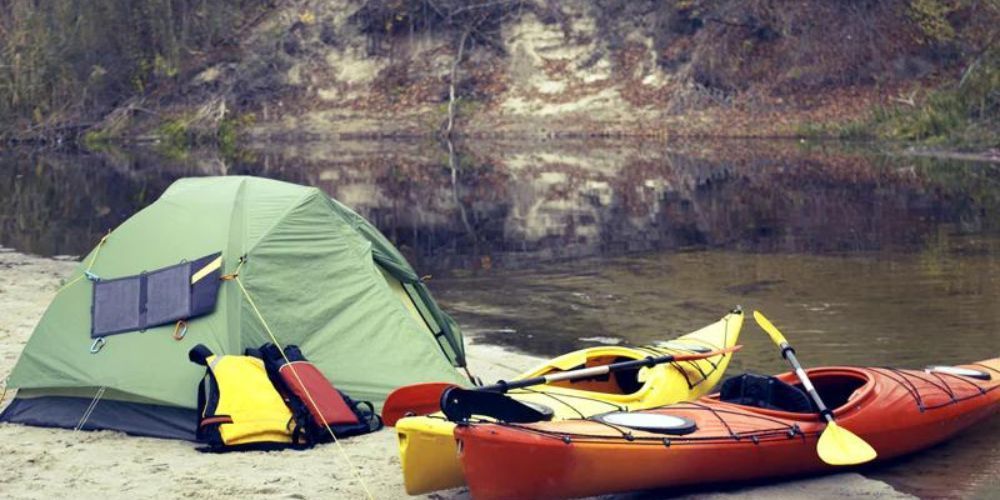
Food and Beverage Supplies
When planning a weekend kayaking trip, packing the right food and drinks is just as important as bringing necessary gear. An active day of kayaking can deplete your energy and fluids, so it's vital to pack enough sustenance to keep you fueled and hydrated. Let's take a closer look at some essential items to consider when packing food and beverages for your kayaking adventure.
Hydration is Key
Proper hydration is crucial when engaging in physical activities like kayaking. Dehydration can lead to fatigue, reduced performance, and even health risks. Therefore, bringing enough water should be your top priority when packing for your trip. Consider utilizing hydration bladders or canteens that are easily accessible while paddling. Aim to bring at least 2-3 liters of water per day, ensuring that you have enough to stay properly hydrated throughout your entire trip.
Additionally, consider including some electrolyte drink mixes in your pack to replenish lost minerals and maintain adequate hydration levels. These mixes can be especially beneficial during hot weather or intense paddling sessions where you sweat profusely.
Non-Perishable Food Options
When it comes to food choices, opt for lightweight, high-energy options that won't spoil during your trip. Items like trail mix, jerky, granola bars, and energy bars are excellent choices as they provide quick bursts of energy without adding unnecessary weight to your gear. It's also wise to pack these items in airtight containers or resealable bags to protect them from exposure to water or moisture.
Furthermore, it's advisable to carry non-perishable foods that require minimal preparation. These items offer convenience and ensure that you can refuel quickly during breaks without having to spend too much time on meal preparation.
Cooking Equipment for Overnight Trips
If you're planning an overnight kayaking expedition, having a portable stove for preparing meals can be incredibly useful. A compact camping stove allows you to cook hot meals, providing nourishment and comfort during your camping experience.
Cooler Bag for Perishable Items
For those looking to enjoy more luxurious meals with perishable ingredients such as fresh fruits, sandwiches, or wraps, investing in a small waterproof cooler bag is worth considering. This type of cooler helps keep perishable items fresh for a day or two, allowing you to indulge in satisfying meals while on your kayaking adventure.
Packing the right food and drinks not only sustains your energy but also contributes significantly to a more enjoyable and comfortable kayaking experience.
As we continue our journey into the world of kayaking essentials, our next stop focuses on a factor critical for safe and enjoyable paddling adventures: Weather and Sun Protection.
Weather and Sun Protection
The weather can change quickly, especially on the water, so it's essential to be prepared. Sun protection is key when spending long hours under the open sky, especially during a full day of paddling. Let's break down some helpful gear and precautions to keep you safe and comfortable throughout your kayaking adventure.
Protection from Harmful UV Rays
The sun's ultraviolet (UV) rays are stronger on the water, with the potential to cause sunburn even on overcast days. To shield your skin from UV exposure, it's important to use high-SPF waterproof sunscreen and reapply it periodically, especially after swimming or sweating. Look for a broad-spectrum sunscreen with an SPF of 30 or higher to guard against both UVA and UVB rays. Even on cloudy days, UV radiation can penetrate through the clouds, so consistent application of sunscreen is paramount.
Aside from sunscreen, wearing protective clothing designed with Ultraviolet Protection Factor (UPF) fabrics can significantly reduce sun exposure. Long-sleeved shirts, pants, and wide-brimmed hats are excellent choices for additional UV protection. Clothes with UPF ratings provide effective defense against harmful sun rays, offering another layer of safeguarding beyond sunscreen application.
Eye Protection from Glare
When kayaking near reflective water surfaces, glare can be intense, causing discomfort and potentially impairing vision. Polarized sunglasses are especially beneficial for reducing glare and enhancing visibility by cutting off horizontal light waves reflected from the water's surface. Additionally, using sunglasses retainers can prevent them from falling into the water unexpectedly, keeping your eyes protected while paddling.
Imagine paddling across the serene surface of a lake or navigating through coastal waters with bright sunlight bouncing off the waves. Polarized sunglasses not only reduce strain on your eyes but also allow better visibility underwater, enhancing the overall kayaking experience.
Weather Monitoring for Safety
While enjoying your kayaking trip, having real-time weather updates can make all the difference in ensuring safety amidst changing weather conditions. Carrying a battery-operated weather radio allows you to stay informed about any approaching storms or unexpected changes in weather patterns, empowering you to make timely decisions about altering your route or seeking shelter as needed.
Ensuring proper weather and sun protection measures are in place adds a layer of safety and comfort to your kayaking experience. From shielding yourself against UV rays to maintaining visibility under diverse lighting conditions, these precautions play a vital role in facilitating an enjoyable outing while safeguarding your well-being.
Camping Equipment and Comfort
Picture this: after a thrilling day paddling through crystal-clear waters, it's time to relax and recharge. The right camping equipment can make all the difference in transforming your evening from standard to spectacular. Let's dive into the must-have camping gear that will elevate your outdoor experience.
Shelter: Lightweight Tent
When it comes to selecting a tent for your kayaking trip, think small and sleek. Look for a compact, waterproof tent that provides enough space for you and your gear while remaining easy to carry. Tents with mesh panels for ventilation are especially useful in warm weather, keeping you comfortable throughout the night.
Sleep System: Sleeping Bag and Pad
After a long day on the water, a good night's sleep is essential. A lightweight, compressible sleeping bag rated for the expected temperature range is a pivotal piece of gear. Keep in mind the climate at your destination and select a sleeping bag that offers adequate warmth without adding unnecessary bulk. Additionally, investing in an inflatable pad can significantly enhance your sleeping comfort by providing cushioning and insulation from the ground.
Investing in an inflatable pad can significantly enhance your sleeping comfort by providing cushioning from the ground. For versatile use, a sleeping bag with a mid-range temperature rating (around 20°F or -7°C) can be a wise choice, offering flexibility for varying weather conditions.
Campsite Relaxation: Camping Chair
Setting up a cozy campsite begins with ensuring comfort beyond just sleeping accommodations. A foldable camping chair provides a comfortable spot for unwinding after a day of exploration. Whether you're savoring sunset views or sharing stories around a campfire, having a place to relax makes all the difference during downtime.
An important factor when selecting a camping chair for your kayaking trip is its portability; lightweight, collapsible designs are preferred as they're easier to transport and store.
Illumination: Portable Lantern
A reliable light source is crucial for tasks after dusk and creating an inviting ambiance around your campsite. Look for a battery-operated or solar-powered lantern that delivers ample illumination while remaining compact and easy to carry. Opting for a lantern with adjustable brightness settings allows you to tailor the light output to your specific needs.
For example, solar-powered lanterns are an eco-friendly alternative that harnesses natural energy during the day, making them ideal for extended outdoor stays where access to power sources may be limited.
A well-chosen selection of camping gear not only enhances your comfort but also ensures you're prepared for any outdoor scenario. With these essential items at your disposal, you're well-equipped to make the most of your weekend kayaking adventure.
Embarking on a weekend kayaking trip equipped with the right gear sets the stage for an exhilarating outdoor escapade combined with moments of tranquility amidst nature's beauty.
What should I pack for a weekend kayaking trip?
Packing for a weekend kayaking trip requires a balance between essentials and space-saving. Start with safety gear: a well-fitted life jacket, a whistle, and a first aid kit. Next, pack weather-appropriate clothing, including a waterproof jacket and quick-drying layers. Don’t forget your paddle, map, or GPS, and a dry bag to keep your belongings secure. Bring enough food and water, along with a portable stove if you plan to cook. Finally, include camping gear like a lightweight tent, sleeping bag, and a compact sleeping pad if you plan to camp overnight. Always consider the specific environment you’ll be kayaking in and adjust your packing list accordingly.
How do I prepare my kayak for a weekend trip?
Preparing your kayak for a weekend trip involves several key steps. First, thoroughly inspect your kayak for any damage, paying close attention to the hull, seams, and any moving parts like hatches or skegs. Make sure your kayak is clean and free of debris. Check all your gear, including your paddle, bilge pump, and spray skirt, to ensure everything is in good working order. Pack your kayak carefully, placing heavier items in the center to maintain balance and lighter items at the ends. Use dry bags to keep your gear safe from water, and distribute weight evenly to avoid tipping. Finally, test your fully loaded kayak in a controlled environment to ensure it handles well and you’re comfortable with the setup before heading out on your trip.
What are some essential safety tips for a weekend kayaking trip?
Safety is paramount on any kayaking trip, especially over a weekend. Start by checking the weather forecast and water conditions before setting out. Always wear a life jacket, regardless of your swimming ability, and carry a whistle or other signaling device in case of emergencies. It’s also important to file a float plan with someone you trust, detailing your expected route and return time. Keep your phone or a VHF radio in a waterproof case and within easy reach. Stay aware of your surroundings, especially when navigating in unfamiliar waters, and know how to perform a self-rescue in case you capsize. Lastly, be mindful of your physical limits and take regular breaks to avoid fatigue.
Check out the latest guides on kayaking gear
Check out the latest guides on camping gear
Author: William Flaiz

